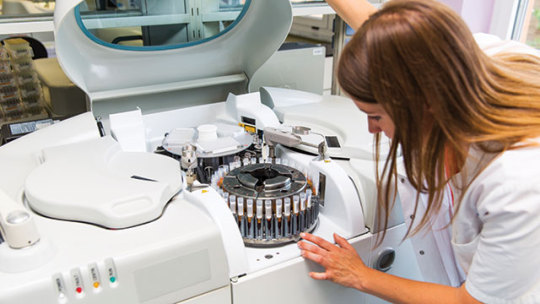#autoverification
Explore tagged Tumblr posts
Text
Connecting the Dots: The Importance of Lab Analyzers Interfacing

In the intricate tapestry of laboratory operations, the seamless integration of lab analyzers is paramount. From chemistry analyzers to hematology instruments, each component plays a vital role in the diagnostic process. However, the true magic happens when these disparate pieces come together through lab analyzers interfacing. This synergy not only streamlines workflow but also enhances the efficiency and accuracy of diagnostic testing.
At the heart of lab analyzers interfacing lies instrument integration. Gone are the days of siloed instruments operating in isolation. Modern laboratories demand interconnectedness, where analyzers communicate harmoniously to deliver cohesive results. Through advanced integration protocols, laboratories can orchestrate a symphony of analyses, maximizing throughput and minimizing turnaround times.
Yet, integration is merely the first step. The crux of lab analyzers interfacing lies in data transfer. Patient samples traverse a labyrinth of analyzers, each generating a plethora of data points. Efficient data transfer mechanisms ensure that these valuable insights flow seamlessly from one instrument to another, without loss or distortion. Whether it's transmitting test results or patient demographics, the integrity of data transfer is sacrosanct.

However, the path to seamless interfacing is fraught with challenges, chief among them being compatibility testing. Not all analyzers speak the same language or adhere to uniform data standards. Compatibility testing is akin to deciphering a complex code, ensuring that disparate instruments can understand and interpret each other's signals. Through meticulous testing protocols, laboratories can preempt compatibility issues and preemptively resolve them.
Moreover, effective interface configuration is essential for optimizing analyzers' interoperability. Customized configurations tailor interfaces to the unique needs of each laboratory, ensuring smooth data exchange and minimizing errors. Whether it's defining data formats or establishing communication protocols, meticulous interface configuration is the linchpin of successful lab analyzers interfacing.
In the realm of lab analyzers interfacing, middleware solutions serve as the bridge between disparate instruments. These software platforms harmonize data exchange, transcending the barriers of instrument heterogeneity. Middleware solutions not only facilitate seamless interfacing but also offer advanced functionalities such as result validation and autoverification, further enhancing laboratory efficiency and quality.
In conclusion, lab analyzers interfacing is the linchpin of modern laboratory operations, fostering synergy among disparate instruments and maximizing the efficiency and accuracy of diagnostic testing. Through the seamless integration of instruments, efficient data transfer mechanisms, meticulous compatibility testing, customized interface configurations, and middleware solutions, laboratories can unlock new frontiers of efficiency and excellence. As laboratories continue to evolve in tandem with technological advancements, the importance of lab analyzers interfacing will only grow, cementing its status as a cornerstone of diagnostic excellence.
#Instrument Integration#Data Transfer#Compatibility Testing#Interface Configuration#Middleware Solutions
0 notes
Text
A DIGITAL REVOLUTION IN PATHOLOGY

Laboratory medicine is continuously evolving to provide the much needed support for disease monitoring, treatment decisions and patient safety. With a rise in the adoption of machine learning and artificial intelligence to improve turnover and optimise efficiency, pathology laboratories are transforming into predictive rather than reactive environments.
Diagnostics is the critical first step in the healthcare delivery chain, as 70 per cent of the treatment decisions are based on lab results. The market for diagnostics devices is growing steadily to meet the increasing demand from hospitals and laboratories. The onus is thus on the manufacturer to provide a holistic solution that integrates automation with analytics, training, updates, and troubleshooting. Further, the use of QR codes and RFID chips enables automated tracking of samples and laboratory materials such as reagents, chemicals and equipment.
The role of AI and ML
Today, digitalisation, automation, and laboratory information software (LIS) have found a place in clinical laboratories. However, many lab processes continue to be performed manually or are partially digitised. Efforts are also being taken to improve the pre-analytic, analytic, and postanalytic processes of the clinical laboratories with the AI-support.
The COVID-19 outbreak accelerated the adoption of digital technologies in laboratories. According to a recently published report, several examples of applications of Artificial Intelligence (AI) to COVID-19 are already reported such as AI-enabled outbreak tracking apps, chatbots for diagnostics, AI-powered analysis of scientific publications and triage using natural language processing (NLP) for screening potential patients and prognosis prediction tools, and using radiology CT scans to manage system capacities, among others.
Also available on record are multiple examples of the role played by AI in the management of non-communicable chronic diseases such as cancer and cardiovascular disorders. AI tools aid in augmenting the accuracy of clinical decision and improving patient care.
Studies reveal that AI-supported systems can predict patient waiting time in the phlebotomy unit and organise the entire blood collection process or the autoverification of test results using a Machine Learning (ML) approach. ML can also be used to predict out-ofcontrol events in internal quality control studies, detecting instrument failures before even they occur, or determining compatibility between analysers in central laboratories where several instruments running the same parameters are tested.
Automation of analysers
It is very interesting that the basic manual laboratory techniques and procedures have generally been adopted in principle to automated, or mechanised, fashion in automated analysers, while a wide variety of configurations can be observed in modern instrumentation in clinical laboratory. Step-by-step innovations created these ultimate configurations.
There are several approaches to automated instrumentation historically. For instance, multiple samples are tested in a series in batch analysers. In contrast, in sequential analysers, the samples are tested sequentially, and the results are reported at that order. Continuousflow analysis means a form of sequential analysis with a continuous stream. In random-access discrete analysers, the most common configuration, analyses are performed sequentially on a set of specimens, and each sample can be analysed for a different test selection. In this type of analysis, an interruption can occur in routine working for spanning a stat sample in-between, permitting measurement of a number of and a variety of analytes in each specimen. Discrete term in this type of analysers means that each test of a patient (or a sample) is analysed in a distinct chamber (in a well, cuvette, reaction vessel)
The use of automated analysers has many advantages including reduction of workload, less time consumption per sample analysis, more number of tests done in less time, use of minute amount of sample, decreased chances of human errors, and high accuracy and reproducibility.
Further, Total Laboratory Automation (TLA) systems use conveyor belts to connect pre-analytical specimen processing and other functions directly to an analyser. Such systems also include functions such as post-analytical storage or sorting of specimens or aliquots to be transported to low-volume testing areas—or to be sent to reference laboratories.
At Transasia-Erba Group, we are looking forward to launching exciting new products by 2023. Our R&D labs in France, UK, USA, Austria and India will launch over 10 state-of-the-art analysers in CLIA, molecular, high-end haematology, AI and LIS. Also in the offing is a TLA solution aimed at midand large size laboratories. All these will make Transasia-Erba among the top-five companies globally to have ‘Total solutions in Laboratory Diagnostics.
Digital data management
Modern-day cutting edge smart technologies are giving a much-needed renovation to laboratories and making them ‘smart’. A smart laboratory is nothing but an amalgam of different hardware tools and software that helps in data management, which is one of its integral parts. And when it comes to data management, one cannot ignore the concept of digital data management.
The concept of digital data management generally revolves around utilising tools to store, document, and share, analyse and manage the experimental data. Among all the other software available, Laboratory Information Management System (LIMS) is extremely helpful. LIMS is a software solution that helps in addressing data management, regulatory challenges, and automation. This software is extremely useful in handling laboratory samples and the data. As a result, it helps maintain tests, workflows and reporting techniques that assist in standardising operations.
The most significant part of the LIMS is to enhance the operational efficiency of a lab by streamlining and automating workflows. Also, it eliminates the purpose of manually maintaining information and complying with regulations. An efficient LIMS will easily be able to keep records and report them. As a result, it eliminates the possibility of any human errors.
Benefits of using LIMS
The key advantage of using LIMS is that it provides sample management. It means that with the help of LIMS, it is possible to manage accurate and detailed records of every sample and securely store them. As a result, the data is not lost while it moves from one laboratory to another.
Secondly, the inventory management functionality of LIMS makes it possible to manage reagents and stock supplies. In addition, it also helps in generating automatic recorder alerts in time of depletion of the stock.
Test Management and reporting are the other two benefits of using the Laboratory Information Management System. It is possible to achieve standardised testing structures with the help of LIMS that too with the bonus of providing accurate and complete testing process control.
The Internet of Things
With an increasing focus on offering value-added services, manufacturers are adopting rapidly evolving technologies, such as the Internet of Things (IoT), to meet the huge demand for fully automated products and services.
IoT applications are being used across all industries and healthcare is no exception. In fact, IoT has brought in a lot of ‘convenience’ to the healthcare ecosystem, becoming especially useful for medical device providers. While it offers a host of solutions, it is left to the companies to leverage the potential of IoT to the fullest.
Predictive maintenance
For laboratories, one of the biggest concerns is downtime. Planning for upgrading via cloud-based lab management systems and sophisticated software is a good way to future proof products and reduce the cost of maintaining the instrument. The days of preventive maintenance are long forgotten, now is the time for predictive maintenance. Devices with IoT capability can sense when components are exhibiting faults or when they near their expected end of life and communicate this back to technical support and initiate actions to resolve them – from ordering replacement parts to requesting a completely new device.
Read More: https://www.europeanhhm.com/information-technology/a-digital-revolution-in-pathology
#DigitalPathology#PathologyRevolution#HealthTechInnovation#MedicalDiagnosis#PathologyAutomation#DiagnosticAccuracy#DigitalHealthcare#MedicalTechnology
0 notes
Photo

How to Verify Phone no. for your YouTube channel using Smartphone in 2021🤔 How to Set Custom Thumbnail Video Link in my bio 👉 . . . . . . . #customthumbnail #howtosetcustomthumbnail #phoneverify #autoverification #livestreamingoption #puncha #techcreator #techy #technobubai #bubai30 #Tatari #India #WestBengal #people #patriotism #soccer #business #achievement #flag #football #music #bestsong #internet #competition #sport #mcm #fit #fitfam #fitspo #fitness https://www.instagram.com/p/CIe7Hukgohl/?igshid=p5y9fp0zzr0u
#customthumbnail#howtosetcustomthumbnail#phoneverify#autoverification#livestreamingoption#puncha#techcreator#techy#technobubai#bubai30#tatari#india#westbengal#people#patriotism#soccer#business#achievement#flag#football#music#bestsong#internet#competition#sport#mcm#fit#fitfam#fitspo#fitness
0 notes